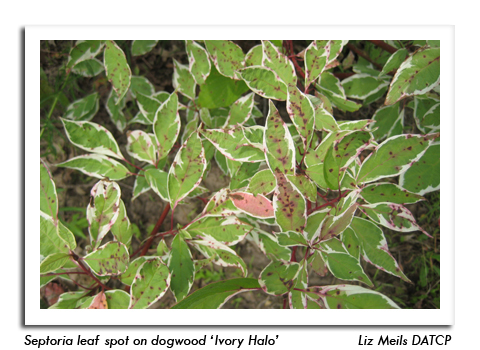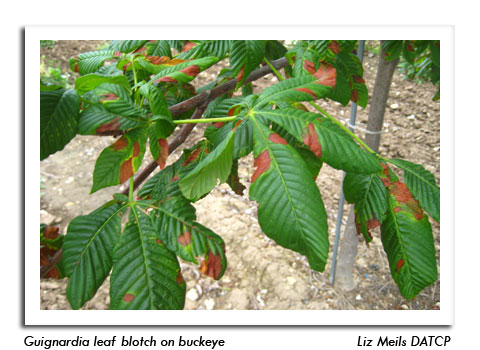
 |
|
|
Nursery & Forest
Volume 59 Number 10 Date 07/10/2014 BASIL DOWNY MILDEW - This fungal-like disease was observed on basil at garden centers in Brown County. First reported in Wisconsin in 2010, basil downy mildew can rapidly devastate basil crops and render plants unmarketable. Diagnostic characteristics include yellowing and downward curling of foliage and grayish-purple, fuzzy sporulation on leaf undersides. This disease thrives under warm, humid conditions, with symptoms progressing from the lower leaves upward. Cultural controls include reducing humidity and leaf wetness, increasing airflow, planting less susceptible varieties, and using clean seed. Any fungicide product used as a preventative measure must be applied before symptoms appear and reapplied at regular intervals. SEPTORIA LEAF SPOT - Dogwood shrubs in Kenosha, Milwaukee, Ozaukee, Washington and Waukesha counties were showing symptoms of this common fungal disease. Diagnostic characteristics are small, dark purple lesions that first appear on the lower leaves and stems and later enlarge and spread to the upper leaves. The simplest cultural control is to increase plant spacing to promote airflow. GUIGNARDIA LEAF BLOTCH - This leaf spot disease is developing on Boston ivy and Ohio buckeye trees in Ozaukee and Washington Counties. Symptoms include irregular, reddish-brown leaf lesions with yellow margins that distort affected foliage as they increase in size and severity. Disease development can be suppressed by disposing of fallen leaves in autumn to reduce inoculum levels. TREE ASSISTANCE PROGRAM - Nursery stock growers and orchardists are now eligible to receive financial assistance for replanting and rehabilitating trees, shrubs and vines damaged by natural disasters as part of the Tree Assistance Program (TAP), authorized by the 2014 Farm Bill and administered by the USDA Farm Service Agency (FSA). The program covers tree losses retroactively back to October 1, 2011. Eligible nursery plants include ornamental, fruit, nut and Christmas trees produced for commercial sale. Nursery growers must have sustained tree losses of 15% or greater to qualify for assistance. The total acreage of planted trees, shrubs or vines for which a grower can receive TAP payments cannot exceed 500 acres per year, and no person or partnership may receive more than $125,000 per year. Nursery operators should contact their local FSA office or USDA service center for additional information. -- Ellen Hermanson, DATCP Nursery Inspector GYPSY MOTH - The second phase of the 2014 gypsy moth aerial spraying program began July 9 with treatments in five southwestern Wisconsin counties: Crawford, Grant, Iowa, La Crosse and Richland. This mid-summer treatment phase, intended to disrupt mating by using a pheromone product specific to gypsy moths, is expected to be completed before the end of the month. Gypsy Moth Program specialists report that the moth flight began on July 9 in the Magnolia and Orfordville areas of Rock County. The last of the state's planned 13,400 pheromone traps were set earlier this week. Results obtained by the annual trapping survey are used to locate emerging gypsy moth populations and determine future treatment sites. -- Rick Hummell, DATCP Gypsy Moth Program 

|
|
|